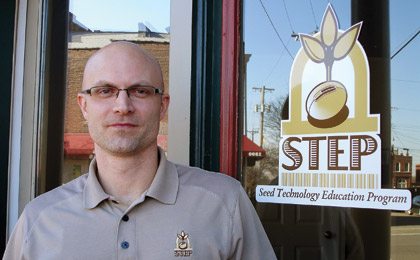As the seed industry prepares for the first biotechnology events to come off-patent, is the sector doing a good job of educating growers on contract obligations?
The first of the commercial biotechnology events will be going off-patent and becoming “generic” in 2015. The expiration of patents for biotechnology events creates opportunities for growers and the seed industry, but also creates challenges that must be addressed.
One of the most important challenges presented by patent expiration of biotechnology events is educating farmers on stewardship obligations so they continue to cultivate seed varieties containing off-patent events without jeopardizing U.S. export markets.
What is the seed industry currently doing to educate farmers on patent expiration, and what more can be done?
Positive STEPs
As the director of the Seed Technology Education Program, an innovative corporation chartered in 2003 to provide customized ancillary support and services to the agriculture industry, Marty Turner has worked with some of the key trait providers in the industry. On a daily basis, he communicates directly with trait developer companies, their dealers and their growers.
“I can only speak to my experience with a portion of the trait dealers across the country, and information that I have read related to the topic, but in my opinion companies like Monsanto are doing anything and everything that they can to avoid grower confusion by providing dealers, growers and stakeholders with information related to patent expiration,” says Turner. “And they are doing so in various formats, methods and media options from print, to on-site meetings, to extensive and up-to-date information online for all to access.”
Last season STEP conducted outreach to 2,200 Monsanto dealers where a key component of those physical visits was to discuss, relay and answer questions about the Roundup Ready 1 soybean patent expiry and to provide the latest industry news about the topic, says Turner. This spring, STEP has undertaken face-to face-visits with nearly 1,700 Monsanto dealers.
“The effort [to educate growers on patent expiration] is there by the trait providers, and the eagerness to know and understand is with the dealers,” Turner says. “What each individual dealer or ag retailer does with the information and how well they relay it to the growers is tougher to gauge. I cannot fairly answer across the board whether or not all are doing everything to relay the information. I can tell you that STEP is in continuous discussion with our clients to determine and plan for ideal education efforts that will facilitate better knowledge and understanding as we have been the past few years on this specific topic; thinking outside of the box and considering larger scale efforts as we near the 2014 planting season.”
Contract Clarity is Key
The onus is really on the growers to take the time to understand their obligations when signing any contracts, including technology agreements. However, Turner says the clearer a tech agreement or contract is, the better.
“A farmer’s seed dealer is the first stop to providing clarity of the contract,” he says. “As the industry strives to provide growers with the very best product options to address yield drag obstacles such as pests, drought and resistance, it becomes increasingly important growers review their contracts to understand any specific restrictions or conditions around a particular technology.”
“As the industry strives to provide growers with the very best product options to address yield drag obstacles such as pests, drought and resistance, it becomes increasingly important growers review their contracts to understand any specific restrictions or conditions around a particular technology.”
— Marty Turner
Facilitating Communication
While there is not an industry standard outlining the information used on seed bags and in contracts, the Biotechnology Industry Organization and the American Seed Trade Association have spearheaded the development of a framework called the Accord to manage the transition of regulatory and stewardship responsibilities for biotechnology events after patent expiration.
The Accord contains two agreements: The Generic Event Marketability and Access Agreement and the Data Use and Compensation Agreement. “The agreements under the Accord provide a legal framework for the seed industry to manage the transition from proprietary to off-patent, or generic, biotech events,” says Bernice Slutsky, senior vice president of domestic and international policy for ASTA. “As we approach patent expiration of biotech events, the Accord agreements will provide predictability to the entire value chain, confidence that trade will be maintained, promote continued innovation in the seed industry, preserve strong protection for intellectual property rights and potentially provide for new business opportunities.”
According to Matt O’Mara, director of international affairs for the Biotechnology Industry Organization, the Accord agreements are intended to promote transparency and facilitate communication. “If you are a signatory to the Accord agreements, you can participate in the processes under the agreements including receiving notices communicating, for example, when a patent will expire for a particular biotech event and who will be providing global regulatory support for the product,” he explains. “Also, as a signatory you can participate in the negotiation of product specific agreements that will outline the details around how the product will be supported globally.”
To learn more about the accord visit agaccord.org. |
While the Accord doesn’t lay out the exact information to be used on seed bags and in contracts, the establishment of this legal framework provides for equitable sharing of ongoing regulatory and stewardship costs and maintains obligations for product stewardship practices—helping companies streamline approaches to patent expiration across the industry.
Spreading the Word to Farmers
Now that the GEMAA is in effect and has 10 signatories, Slutsky says information about biotech events close to patent expiration will be widely available via the Accord website. Seed companies can then relay that information to their farmer customers.
“Also, the Accord has been developed to enable national trade and industry organizations to sign onto the Accord agreements to help facilitate communication to farmers,” says Slutsky. “This is a critical component of communicating with farmers and one of the many benefits of having the Farm Bureau, the American Soybean Association and the National Corn Growers Association as signatories to the GEMAA.”
Tailoring Existing Stewardship Programs
There are also some existing stewardship programs and committees that are starting to look at patent expiration and will make an effort to address the challenges.
The Excellence Through Stewardship program, an initiative to promote the global adoption of stewardship programs and quality management systems for the full life cycle of biotechnology-derived plant products, does not directly deal
with patent expiration right now. “We do, however, as part of the life cycle approach to stewardship, which includes crop production, direct organizations to implement product management practices to enable appropriate use of their products,” says Chris Holdgreve, executive director of ETS. “This would include product and technology use guidance and conditions of use for producers that could, depending on applicability, include a wide range of things from resistance management issues to something like patent expiration.”
The program includes a third-party independent auditing component through which members are audited across the stages of the product life cycle that are applicable to their operations. “This would include everything from stewardship and quality management practices in the labs through to a decision to discontinue a product that has reached the end of its life cycle and is being replaced or no longer sold,” explains Holdgreve.
“The ETS program is focused on best practices through the life cycle—which represent time-tested, successful approaches to the responsible management of products. I would expect as the issue of product expiration continues to advance—through the efforts of BIO, ASTA and the companies involved—there will additional guidance developed through ETS on this issue,” he adds. ETS currently has a Guide for Product Discontinuation of Biotechnology-Derived Plant Products, which Holdgreve says will be the likely spot for additional guidance on product expiration.
On the whole, Turner feels the industry is working together to educate growers on patent expiration and proper use of seed. “Improvements are seen every season and I have seen evidence of this from the trait providers,” he says.
For example, in 2011 the Agricultural Biotechnology Stewardship Technical Committee launched a new insect resistance management on-farm assessment program that focuses more assessments on growers who may not have purchased sufficient refuge seed according to their purchase records.
“At the end of the day, the ultimate responsibility does fall on the grower to gather the information that they need for the products that they are planting, and to then do their very best to abide by those requirements,” says Turner. “But expectations should be set and communicated by the trait providers to the dealers, who are then obligated to adequately relay those to the grower.”
Julie McNabb
 |
Detailed information on the facts surrounding Roundup Ready soybean expiration can be found at monsanto.com |
|
Educating Growers As director of the Seed Technology Education Program, Marty Turner works with trait providers and dealers on patent expiration education. He relays the following key points to seed dealers regarding Roundup Ready 1 patent expiry after the 2014 season: 1) Take the time to read and understand the information provided by your trait provider(s); stay up to date on the latest. • Ask and demand clarification if needed in order to answer growers’ questions. 2) Make clear, for RR1 specifically, the following facts are shared with the grower: • There are still two full seasons before any RR1 beans can even be considered for saving and replanting in the 2015 spring planting season at the earliest. • The seed dealer and perhaps the seed company itself needs to be consulted to determine if the specific variety that is being planted can be saved and replanted; it is very likely there are patents on that variety that are held by breeders or the company. It is likely that many RR1 varieties that will be available to plant in 2014 will still be illegal to save and plant in 2015 due to such patents. 3) Roundup Ready 2 Yield soybeans are NOT coming off-patent anytime soon and cannot be saved. |














